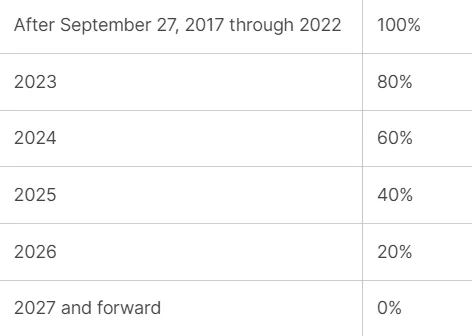COMMERCIAL SOLAR PANEL DEPRECIATION
Depreciation is a great benefit for commercial solar panel installations. It’s one of the easiest ways businesses and agricultural property owners can keep installation costs down, ROIs high, and paybacks short. Put simply, depreciation is a decline in an asset’s value over time. Your business can use this to recover costs from purchases as the equipment’s value degrades throughout its lifetime.
There are a few different ways to expense depreciation, but we’re going to focus on depreciating your solar system using the Modified Accelerated Cost Recovery System, or MACRS depreciation, with a portion of the federal benefits accelerated to year one.
At BCSC LLC, we are expert solar installation professionals, not accountants. We give the most accurate outlook we can based on the financial information provided to us by our customers, but before making any decisions on how to expense depreciation, we recommend checking with your CPA first.

Accelerated Bonus Depreciation for Commercial Solar Installations
As a business owner or CFO, you understand the importance of making strategic investments that yield both financial returns and environmental benefits. The type of investment you choose plays a significant role in the equation of determining the recovery period of your investment.
A commercial solar investment has the benefit of offering 60% bonus depreciation in year one on the federal level. The remaining balance will follow the five-year MACRS (Modified Accelerated Cost Recovery System) schedule. On the state level, the depreciation will follow the standard five-year MACRS schedule.
Compared to many other business investments, solar energy provides a great tool for businesses to offset a significant portion of their tax liability in a relatively short period while also reducing an annual increasing operating cost (energy).
Is Solar Depreciation Calculated Before or After the Federal Solar Tax Credit (ITC)?
The IRS reduces the basis for depreciation by one-half of the tax credit amount allowed. So since the tax credit is 30%, the depreciable basis would be 85% of the total cost (100% – [30% X .5]). For example, if your solar system costs $100,000,000 you would be able to depreciate $850,000 of the system cost.
Note: For property acquired after September 27, 2017, and before January 1, 2023, the law allowed taxpayers to take a deduction amounting to 100%. That dropped to 80% in 2023 and will continue to step down by 20% each year until it reaches 0% in 2027.
Federal Depreciation vs State Depreciation For Commercial Solar Panels
The Tax Cut and Jobs Act changed how we can depreciate solar on the federal level. Prior to 2023, businesses could depreciate 100% of the cost basis in the first year. Since then the accelerated depreciation base has decreased by 20% a year, leaving it at 60% in 2024. This will continue to decrease by 20% a year until it reaches 0% in 2027.
Businesses can still depreciate 100% of the cost basis, but the remaining 40% will follow the five-year MACRS schedule.
An Example of How Commercial Solar Depreciation Works
Let’s figure out the MACRS depreciation for a solar panel system that costs $300,000 before incentives. You’ll be able to take advantage of the Federal Solar Incentive Tax Credit at 30%. But since we have to calculate depreciation with half of the tax credit, reducing the depreciable cost basis, we’ll have to take 15% off the cost of the system to get the basis of depreciation. We can do this by multiplying the cost by 85%, which gives us $255,000.
Next, you’ll need to know your federal and state tax brackets. We’ll use a 24% federal tax rate and a 7% state tax for this example.
To calculate federal tax savings from depreciation, multiply the $255,000 by 24%. Because you can take advantage of 60% of this in the first year, you’ll enjoy $36,720 in savings that will offset your tax liability the year that your solar system is placed into service. The remaining $24,480 of the depreciable amount will follow the MACRS schedule.
To get state savings, multiply $255,000 by your state tax rate, which in this case is 7%. You’ll get $17,850 spread over the 5-year MACRS schedule.
That means the total savings from just depreciation would be $79,050. In this example, that’s 26.3% of the entire solar system’s cost! Adding in the 30% Federal investment tax credit ($90,000) brings total tax incentives on this project to $169,050 or 56% of the project’s cost! No wonder so many companies are going solar!
Contact Us
Want to minimize your organization’s Federal tax liability through Federal and state depreciation? Inquire today for a commercial solar quote through the contact us button below!
This blog provides an overview of the federal and depreciation available for businesses that own solar facilities. It does not constitute professional tax advice or other professional financial guidance and may change based on additional guidance from the Treasury Department. Please consult a licensed tax professional regarding your organizations specific situation as we are not tax advisers.

